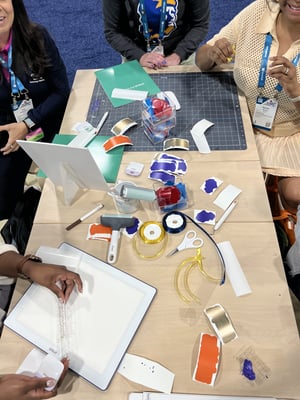Making a Pop-Up Book

.jpg?width=1200&length=1200&name=20240327_084350%20(1).jpg)

.jpg?width=1200&length=1200&name=20240327_121156%20(1).jpg)
Description of Cricut Lesson & Activity
Participants will be able to write and create their own pop-up story in Cricut Design Space after reading and analyzing other stories.
Created For Educators By:
OTIS for educators!

- English
- Literacy
ISTE Standards
- 1.1 Empowered Learner
1.1d Technology Fundamentals - 1.2 Digital Citizen
1.2.d Digital Privacy - 1.3 Knowledge Construction
1.3.c Curate Information - 1.4 Innovative Design
1.4.a Design Process
1.4.d Open-Ended Problems - 1.5 Computational Thinking
1.5.d Algorithmic Thinking - 1.6 Creative Communication
1.6.b Original and Remixed Works
1.6.d Customize the Message - 1.7 Global Collaborator
1.7.a Global Connections
State / Local / Other Standards
- CCSS.ELA-Literacy.W.5.3
Write narratives to develop real or imagined experiences or events using effective technique, descriptive
details, and clear event sequences. - CCSS.ELA-Literacy.W.5.6
With some guidance and support from adults, use technology, including the Internet, to produce and
publish writing as well as to interact and collaborate with others; demonstrate sufficient command of
keyboarding skills to type a minimum of two pages in a single sitting.

TOUCH
Project in Cricut Design Space
For full project details, open in Cricut Design Space.
Click Here
Project in Cricut Design Space
For full project details, open in Cricut Design Space.
Click Here
Click Here
TOUCH
Lesson Plan
For use in your classroom, download full lesson plan.
Download Here

TOUCH
Lesson Rubric
For full assessment rubric, download here.
Download Here
Learning Objective(s)
- Read and analyze a short story to identify story structure and characteristics.
- Brainstorm narrative topic ideas and map out the story’s structure.
- Brainstorm and develop imagery to accompany the storyline.
- Create a rough draft of their story and refine ideas and imagery.
- Design and create a multi-layered pop-up book.
Materials Required
- Printed or digital story (chosen by the instructor)
- Chart paper
- Scrap paper for brainstorming
- Cricut Design Space
- StandardGrip or LightGrip mat
- Medium weight cardstock
- Scoring wheel (#01)
- Cricut markers (if using)
- Printer and copy paper (if using)
- Ruler
- Glue
- Markers
- Various craft materials
Instructions
Introduction
- Start off by asking participants what their favorite stories or books are and why.
- After engaging in a brief discussion or an idea exchange activity, such as paper snowballs, show participants a story. This story should ideally feature pop-out imagery (ex- Alice and Wonderland by Lewis Carroll and Robert Sabuda) if using a
printed text. Have them predict what the story will be about based on the title, book cover, and other features. - Introduce the narrative arc and complete an arc together as a group using the example story. Discuss what the key ingredients or components of a good story are and what features should be included as part of a complete narrative.
- Lastly, evaluate the artwork in terms of its quality and whether it enhances and
supports the story or is irrelevant or detracts from the story.
Session Activity
- Provide participants with time to brainstorm topic ideas for their own short story and jot down notes related to key information such as: characters, what will happen, where it will happen, how it will happen, and why it will happen (the 5 Ws).
- Once the topic has been chosen, and the key elements identified, task each
participant with creating their narrative arc. After this is completed, they should begin by creating a first draft of their story and sketching out illustrations that will help to tell their story. - After the rough draft has been completed, have each person find a partner to review their work and provide feedback on both the story and the illustrations. When the review and feedback process is complete, participants should write a final draft.
- With a final story and illustration ideas in hand, participants may now begin bringing their story to life in Cricut Design Space. Have each participant determine which illustrations they want drawn by hand, digitally as a custom SVG to print and cut, or
as cardstock cutouts. - Start by adding the pop-up pages to the canvas and determining the size (use the pop-up book page templates or have participants create their own). Ensure that the number of pages reflects the number of pages that will be in the story. Then, add
images, shapes, SVGs, etc. to the canvas and size appropriately using the template size as a guide. Determine where the text will go and build spaces into the pages accordingly. - Participants should add text and format to be completed as a print and cut or a writing option using the pen attachment. Alternatively, text can be handwritten.
- Last, design the book cover complete with the title of the story and the author’s name.
- When everything is good to go, provide each participant with the opportunity to have all materials cut, printed, or written using the Cricut. Once all components are ready, they can begin attaching the imagery and text to the pages using glue. Account for additional time that participants may need to troubleshoot placements and sizing of the book components.
Closing
Choose one of the following to celebrate the pop-up stories:
- Allow each participant to present and read their story to the group, OR
- Have all of the completed stories on display for participants to explore and read
independently as part of a gallery walk or “book fair.”
Assessment
- Have each person think about what they learned about themselves as writers and
creators. - Ask participants to reflect on their story creation process within Design Space and
what they would do differently or keep the same if they were to complete this task
again.
Extensions and Customizations
- Have participants engage in a free-write at the beginning of the session or give them
a prompt such as “Write about a time when you ________” - Provide time for participants to complete a narrative arc and story analysis for other
texts that they have independently read or read as part of a larger group. - Provide story templates or pre-cut materials to help participants create their own story.
